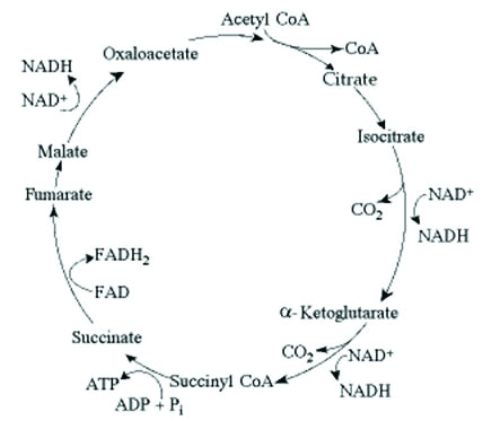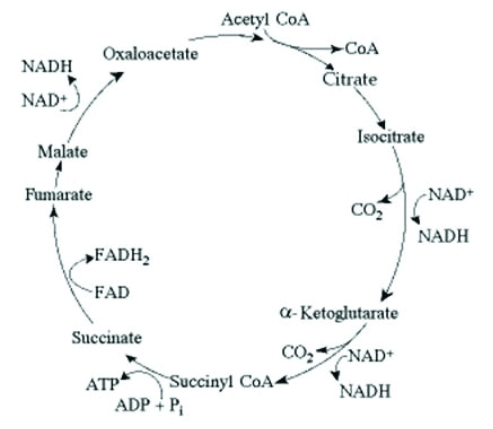A) glycolysis and the oxidation of pyruvate to acetyl CoA
B) oxidation of pyruvate to acetyl CoA and the citric acid cycle
C) oxidative phosphorylation and fermentation
D) fermentation and glycolysis
F) A) and B)
Correct Answer

verified
Correct Answer
verified
Multiple Choice
Which of the following metabolic processes take place in the cytosol of a eukaryotic cell?
A) glycolysis and fermentation
B) fermentation and chemiosmosis
C) oxidation of pyruvate to acetyl CoA
D) citric acid cycle
F) A) and B)
Correct Answer

verified
Correct Answer
verified
Multiple Choice
If glucose is the sole energy source for cellular respiration in an animal, what proportion of the carbon dioxide exhaled is derived from oxidation of pyruvate to acetyl CoA?
A) 1/6
B) 1/3
C) 2/3
D) 100%
F) A) and C)
Correct Answer

verified
Correct Answer
verified
Multiple Choice
When electrons flow along the electron transport chains of mitochondria, which of the following changes occurs?
A) The pH of the matrix increases.
B) ATP synthase pumps protons by active transport.
C) The electrons gain free energy.
D) NAD+ is oxidized.
F) A) and B)
Correct Answer

verified
Correct Answer
verified
Multiple Choice
The synthesis of ATP by oxidative phosphorylation is an example of which of the following processes?
A) active transport
B) allosteric regulation
C) a reaction with a positive ΔG
D) coupling of an endergonic reaction to an exergonic reaction
F) All of the above
Correct Answer

verified
Correct Answer
verified
Multiple Choice
 The citric acid cycle.
Which of the following is the most likely effect on the rates of ATP and CO2 production if yeast cells growing in minimal medium lacking glucose are provided with supplemental acetyl-CoA?
The citric acid cycle.
Which of the following is the most likely effect on the rates of ATP and CO2 production if yeast cells growing in minimal medium lacking glucose are provided with supplemental acetyl-CoA?
A) There would be no change in ATP production, but the rate of carbon dioxide production would increase.
B) The rates of ATP production and carbon dioxide production would both increase.
C) The rate of ATP production would increase, but the rate of carbon dioxide production would decrease.
D) The rates of ATP and carbon dioxide production would both decrease.
F) A) and B)
Correct Answer

verified
Correct Answer
verified
Multiple Choice
In the absence of oxygen, yeast cells can obtain energy by fermentation, which results in the net production of which of the following sets of molecules?
A) ATP, CO2, and ethanol
B) ATP, CO2, and lactate
C) ATP, NADH, and ethanol
D) ATP, CO2, and acetyl CoA
F) C) and D)
Correct Answer

verified
Correct Answer
verified
Multiple Choice
Which of the following events takes place in the electron transport chain?
A) the breakdown of glucose into six carbon dioxide molecules
B) the breakdown of an acetyl group to carbon dioxide
C) the harnessing of energy from redox reactions to generate a proton gradient
D) substrate-level phosphorylation
F) None of the above
Correct Answer

verified
Correct Answer
verified
Multiple Choice
A 3-year old dog has never been able to tolerate much physical activity. A veterinarian discovers that the dog's mitochondria can use only fatty acids and amino acids for cellular respiration, and its muscle cells produce elevated levels of lactate. Which of the following statements best explains the dog's condition?
A) Its cells cannot transport pyruvate from the cytosol into the mitochondria.
B) Its cells cannot transport NADH from glycolysis into the mitochondria.
C) Its cells cannot complete glycolysis.
D) Its cells have a defective electron transport chain, so glucose is metabolized to lactate instead of to acetyl CoA.
F) All of the above
Correct Answer

verified
Correct Answer
verified
Multiple Choice
Upon completion of the citric acid cycle, most of the energy originally stored in each glucose molecule catabolized by cellular respiration is stored in which of the following molecules?
A) acetyl-CoA
B) ATP
C) CO2
D) NADH
F) B) and C)
Correct Answer

verified
Correct Answer
verified
Multiple Choice
What types of cells carry out ATP synthesis by chemiosmosis?
A) all cells, both prokaryotic and eukaryotic, exclusively using oxygen as the electron acceptor
B) only animal cells in mitochondria, exclusively using oxygen as the electron acceptor
C) only eukaryotic cells, both plant and animal, using either oxygen or other electron acceptors
D) all respiring cells, both prokaryotic and eukaryotic, using either oxygen or other electron acceptors
F) C) and D)
Correct Answer

verified
Correct Answer
verified
Multiple Choice
When a cell is deprived of oxygen, which of the following processes will be inhibited first?
A) glycolysis
B) the electron transport chain
C) the citric acid cycle
D) the oxidation of pyruvate to acetyl CoA
F) A) and C)
Correct Answer

verified
Correct Answer
verified
Multiple Choice
Most CO2 from catabolism is released during ________.
A) glycolysis
B) the citric acid cycle
C) lactate fermentation
D) electron transport
F) C) and D)
Correct Answer

verified
Correct Answer
verified
Multiple Choice
Which of the following statements best summarizes ATP use and production in the catabolism of each glucose molecule in glycolysis?
A) two molecules of ATP are used, and two molecules of ATP are produced
B) two molecules of ATP are used, and four molecules of ATP are produced
C) four molecules of ATP are used, and two molecules of ATP are produced
D) four molecules of ATP are used, and four molecules of ATP are produced
F) B) and C)
Correct Answer

verified
Correct Answer
verified
Multiple Choice
Which of the following best predicts the effect of removal of oxygen from a facultative anaerobic organism's environment?
A) glucose consumption increases, while the growth rate decreases
B) glucose consumption and the growth rate both increase
C) glucose consumption decreases, while the growth rate increases
D) glucose consumption decreases, while the growth rate remains unchanged
F) A) and B)
Correct Answer

verified
Correct Answer
verified
Multiple Choice
Exposing inner mitochondrial membranes to ultrasonic vibrations will fragment the membranes and pieces will reseal "inside out" to form small vesicles. The fact that these vesicles can transfer electrons from NADH to oxygen and synthesize ATP suggests that which of the following components must be present?
A) only the electron transport system
B) only the ATP synthase system
C) all of the electron transport system and the proteins that add CoA to acetyl groups
D) all of the electron transport system and ATP synthase
F) C) and D)
Correct Answer

verified
Correct Answer
verified
Multiple Choice
Glycolysis results in the net production of which of the following sets of molecules per glucose molecule?
A) 2 NAD+, 2 pyruvate, and 2 ATP
B) 2 NADH, 2 pyruvate, and 2 ATP
C) 4 NADH, 2 pyruvate, and 4 ATP
D) 6 CO2, 2 pyruvate, and 2 ATP
F) All of the above
Correct Answer

verified
Correct Answer
verified
Multiple Choice
 The citric acid cycle.
For each mole of glucose (C6H12O6) oxidized by cellular respiration, how many moles of CO2 are released in the citric acid cycle (see the accompanying figure) ?
The citric acid cycle.
For each mole of glucose (C6H12O6) oxidized by cellular respiration, how many moles of CO2 are released in the citric acid cycle (see the accompanying figure) ?
A) 2
B) 4
C) 6
D) 32
F) A) and C)
Correct Answer

verified
Correct Answer
verified
Multiple Choice
Assume that it is possible to label each of the molecules below with 18O a heavy isotope of oxygen. As a result of cellular respiration, water containing 18O would most quickly be detected if cells are provided with which one of the following molecules labeled with 18O?
A) carbon dioxide (CO2)
B) glucose (C6H12O6)
C) molecular oxygen (O2)
D) pyruvate (C3H3O3)
F) B) and C)
Correct Answer

verified
Correct Answer
verified
Multiple Choice
Which of the following products result from the oxidation of pyruvate to acetyl-CoA?
A) O2 and ATP
B) FADH2 and CO2
C) NADH and CO2
D) NAD+, ATP and CO2
F) All of the above
Correct Answer

verified
Correct Answer
verified
Showing 41 - 60 of 68
Related Exams